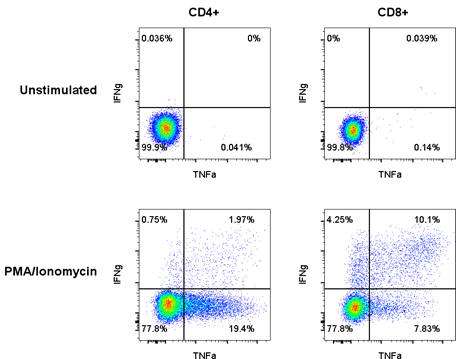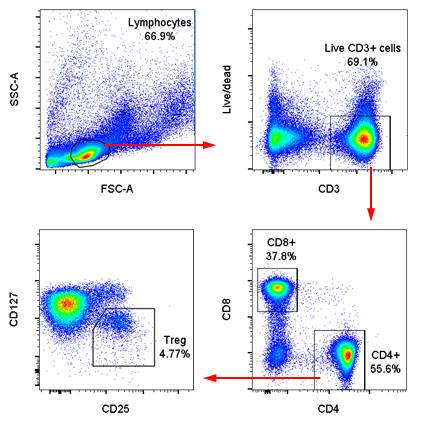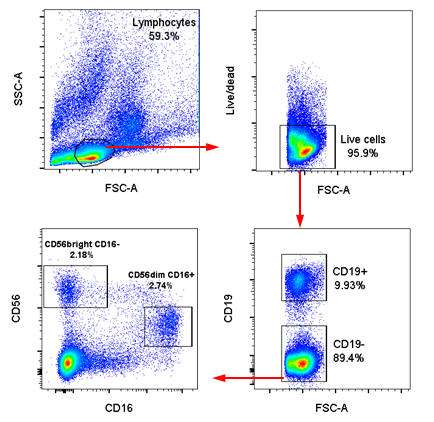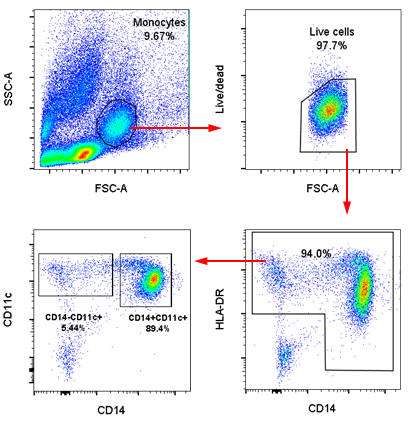Your basket is currently empty!
Immunocytometry Assay Service
Immunocytometry Assay Service
our high throughput flow cytometry core facility and cell based-assay platforms at your fingertips
Make the most of your study samples
Flow cytometry is a powerful technique that allows the analysis of individual cells in a mixed population. By outsourcing your flow cytometry staining experiments to ProImmune, you take advantage of our technical proficiency and save time by passing collection and analysis of data to our experts.
What is Immunophenotyping?
Immunophenotyping by flow cytometry enables expressed proteins on the surface of individual cells to be detected in order to define populations of interest. Cell subset identification may be combined with the analysis of activation status markers, homing markers or exhaustion markers.
ProImmune has experience in designing bespoke immunophenotyping panels, with the capability of detecting up to 8 colours simultaneously. Previous immunophenotyping panels have included:
- T cells including markers to discrimate naive, central memory, effector memory and terminally differentiated effector memory cells: CD3, CD4, CD8, CD45RA, CD62L
- Regulatory T cells: CD3, CD4, CD127, CD25
- B cells: CD19, CD20, CD38, CD27
- Natural killer (NK) cells and NKT cells: CD56, CD3, CD16
- Activation markers: CD69, HLA-DR
- Monocytes and dendritic cells (DCs): CD14, CD16, HLA-DR, CD11b, CD11c, CD209, CD86
We can also include a ‘dump’ channel to maximize color usage, and generally incorporate a live/dead stain. Previous controls include unstimulated samples, isotype controls and Fluorescence Minus One (FMO).
What is Intracellular Cytokine Staining?
Intracellular cytokine staining (ICS) by flow cytometry allows for the analysis of specific T cell responses in defined cell populations. Compared to the ELISpot technique, ICS combines immunophenotyping with the simultaneous detection of cytokines, providing instantly more information about the immune response. In addition, multiple cytokines from the same cell may be detected, facilitating the assessment of polyfunctionality.
ICS relies upon the stimulation of immune cells in the presence of an inhibitor of protein transport to retain the cytokines inside the cell. Cells are first activated with antigen, followed by staining with antibodies specific for particular cell populations, such as CD4 and/or CD8. The cell membranes are then permeabilized prior to staining with fluorochrome-conjugated cytokine-specific antibodies. ICS is commonly used for the detection of human IFN-gamma, IL-2 and TNF-alpha cytokine production in CD4+ and CD8+ T cells.

Figure 1. Example of human PBMCs stained with a ICS panel. Unstimulated and PMA/Ionomycin-stimulated PBMCs were gated first on live CD3+ lymphocytes, followed by CD4+ and CD8+ populations being identified. In this particular ICS panel, IFN-gamma and TNF-alpha production was assessed. PMA/Ionomycin stimulation resulted in nonspecific T cell activation, with IFN-gamma and TNF-alpha release in both CD4+ and CD8+ T cells.
ICS can be used as an immune monitoring tool to measure the immune response to known antigens, or for epitope discovery, combined with ProImmune’s REVEAL® & ProVE® technology, to identify and/or validate novel T cell epitopes. Read more about ICS
Example of Flow Cytometry Assay Service
ProImmune is able to analyze either the effect of compounds on immune cells or to assess samples from clinical studies. In this clinical study example, the aim was to compare two cohorts by immunophenotyping PBMCs, identifying classic cell subtypes, and analyzing the cohorts for any differences in the frequency of cell subtypes.

Figure 2. Human PBMCs stained with a T cell antibody panel. The gating strategy involved first identifying the lymphocyte population by forward scatter (FSC) and side scatter (SSC). Live T cells (CD3+) were gated and then the two main types of T cells were defined by CD4+ (T helper cells) and CD8+ (cytotoxic T cells). In addition, the CD4+ T cells were further analysed to identify regulatory T cells (Tregs), known to be CD4+CD25+CD127lo/-.

Figure 3. Human PBMCs stained with a B cell and natural killer (NK) cell antibody panel. The gating strategy involved first identifying the lymphocyte population by FSC and SSC. Live cells were gated and then B cells (CD19+) removed from all other cell populations. By using a CD16 v CD56 plot, NK cells may be identified and subdivided to give the two main types: CD56brightCD16- and CD56dimCD16+ cells. CD56dim NK cells are thought to be the more cytotoxic NK cells, while CD56bright NK cells are the most efficient cytokine producers.

Figure 4. Human PBMCs stained with a monocyte antibody panel. The gating strategy involved first identifying the monocyte population by FSC and SSC. Live cells were gated and then true monocytes (and dendritic cells) identified. A CD14 v CD11c plot was used to define monocytes (CD11c+CD14+) and myeloid dendritic cells (CD11c+CD14-).
Immunophenotyping and Intracellular Cytokine Staining as an Outsourced Service
Multi-center clinical trials pose the challenge of collecting, shipping and processing samples in a way that ensures consistency and repeatability. Sample logistics and preparation is probably the most important step in setting up successful assays for monitoring cell mediated immune responses. We have the experience and the capability to collect your samples wherever you are in North America and Europe and process them for maximum uniformity; sample preparation and shipping.
Our flow cytometry assay service is based on a standardized format, which follows this step-by-step process:
(1) Customer cryopreserves cells in accordance with optimized protocol recommended by ProImmune or optimized customer protocol;
(2) ProImmune collects cells from customer site using validated shipper (customer may also use their own shipper),
a. ProImmune carries out HLA tissue typing as an option if required,
b. ProImmune carries out custom peptide synthesis as an option if required;
(3) ProImmune thaws cells with optimized protocol and carries out immunophenotyping and/or intracellular cytokine staining in accordance with standardized procedure.
(4) Customer receives assay report, including flow cytometry staining data, plus raw data .fcs files on CD.
The delivery time for a project will vary depending on the specific requirements, but a turnaround time of 3-5 weeks (including peptide synthesis and shipment of cells) can be expected for an average project.
Contact us if you require immunophenotyping or intracellular staining for other cell markers or cytokines.
Flow cytometry Testing with Pro5® MHC Class I Pentamers
ProImmune offers a flexible flow cytometry testing service for measuring antigen-specific CD8+ T cell responses using MHC Class I Pentamers.
Pro5® and ProVE® MHC Class I Pentamers bind directly to T cell receptors of a particular specificity, determined by the MHC allele and peptide combination, and can detect antigen-specific T cell populations as rare as 0.02% of lymphocytes.
Staining cells with MHC Pentamers provides a quantitative analysis of lymphocytes that express a specific T cell receptor and in conjunction with other functional assays, such as ELISpot, gives complementary information about an immune response.
Even for researchers experienced in flow cytometry techniques, cell preparation, staining and analysis all require careful planning and execution. By outsourcing flow cytometry testing to ProImmune, you immediately benefit from many years experience from the team that has developed MHC Pentamer technology. Protocols are carried out to optimized procedures to give reliable and consistent results.
Our affordable, streamlined service is based on simple standardized formats, which follow this step-by-step process:
(1) Customer cryopreserves cells in accordance with optimized protocol recommended by ProImmune or optimized customer protocol.
(2) ProImmune collects cells from customer site using validated shipper (customer may also use their own shipper)
– ProImmune carries out HLA tissue typing as an option if required
(3) ProImmune thaws cells with optimized protocol and carries out Pro5® or ProVE® Pentamer staining and flow cytometry analysis in accordance with one or more of the following assay formats:
a. Immune monitoring: Staining with Pro5® Pentamer vs. anti-CD8 and anti-CD19 (for negative gating of B cells) on frozen, unmodified PBMC.
b. Epitope validation: Staining with individual ProVE® Pentamers or pools of Pentamers vs. anti-CD8 and anti-CD19 (for negative gating of B cells) on frozen ,unmodified PBMC.
(4) Customer receives full assay report and raw data.
By request these processes can be easily adapted to any additional or alternative requirement.
Epitope Validation Using Pentamer Staining
The REVEAL® & ProVE® Rapid Epitope Discovery System determines candidate T cell epitopes from a starting set of peptides such as overlapping peptides from a protein, or peptides that have been pre-scored or pre-validated in any other way.
Candidate sequences identified with the REVEAL® MHC-peptide binding assay can be validated either by ELISpot analysis or with MHC Class I Pentamers in flow cytometry. Our cellular analysis services can be integrated with this process to provide seamless epitope discovery and validation. The customer only needs to provide the cell samples to be used in the validation step.
For example, in the discovery of new CD8+ T cell epitopes, libraries of epitope-specific ProVE® Pentamers can be used to identify and quantify the antigen-specific CD8+ T cells, and thus validate the T cell epitopes. Detection of positive staining with Pentamer against an appropriate negative control means that expanded T cells are present in the donor sample that are specific to the peptide and MHC allele under investigation. This is the most definitive confirmation achievable for a T cell epitope, and confirms its minimal binding sequence and allelic restriction.
It is possible to stain a single cell sample with a pool of unlabeled Pentamers as a rapid screen for positive responses. Pooling MHC Pentamers together for screening purposes reduces the total number of cells required, and subsequently, the time spent staining and analyzing samples.
Case Study: Multiple staining with a pool of unlabeled Pentamers
